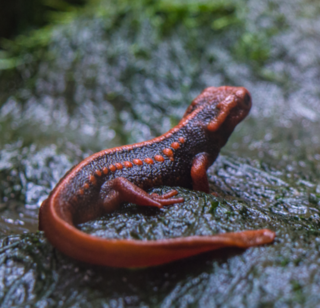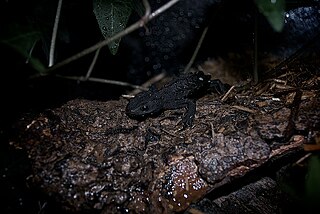
Salamandridae is a family of salamanders consisting of true salamanders and newts. Currently, 74 species have been identified in the Northern Hemisphere - Europe, Asia, the northern tip of Africa, and North America. Salamandrids are distinguished from other salamanders by the lack of rib or costal grooves along the sides of their bodies and by their rough skin. Their skin is very granular because of the number of poison glands. They also lack nasolabial grooves.

Tylototriton shanjing, the emperor newt, Mandarin newt or Mandarin salamander, is a highly toxic newt native to China.

Tylototriton verrucosus is a species of newt found in the Indian subcontinent and Southeast Asia. Common names include: Himalayan newt, crocodile newt, crocodile salamander, Himalayan salamander, red knobby newt.

Neurergus kaiseri, the Luristan newt, Kaiser's mountain newt, Kaiser's spotted newt or emperor spotted newt, is a species of very colourful salamander in the family Salamandridae. It is endemic to the southern Zagros Mountains in Iran where it is known from just four streams. Populations of this newt have been declining and the International Union for Conservation of Nature has rated it as "vulnerable". A captive breeding programme has been established in several zoos.
The black knobby newt is a species of salamanders in the family Salamandridae found in China and Vietnam. Its natural habitats are subtropical or tropical moist lowland forests, subtropical or tropical moist montane forests, freshwater marshes, and intermittent freshwater marshes. It is threatened by habitat loss and overharvesting.
The Hainan knobby newt is a species of salamander in the family Salamandridae. It is found only in the island of Hainan, China. It is known from the Wuzhi Mountains, Diaoluoshan, and Jianfengling. All these locations are nature reserves. Nevertheless, the species is threatened by habitat loss and degradation due to agriculture, clear-cutting and infrastructure development for tourist activities.
The Taliang knobby newt is a species of salamander in the family Salamandridae. It is found only in southern Sichuan, China. It inhabits densely vegetated forested valleys, where it breeds in pools, ponds and paddy fields. It is a common species within its confined range.

The Wenxian knobby newt or Wenxian knobby salamander is a species of salamander in the family Salamandridae. It is endemic to central China. Its type locality is Wen County in Gansu, or in Chinese: 文县; pinyin: Wénxiàn, hence the name.

A newt is a salamander in the subfamily Pleurodelinae. The terrestrial juvenile phase is called an eft. Unlike other members of the family Salamandridae, newts are semiaquatic, alternating between aquatic and terrestrial habitats. Not all aquatic salamanders are considered newts, however. More than 100 known species of newts are found in North America, Europe, North Africa and Asia. Newts metamorphose through three distinct developmental life stages: aquatic larva, terrestrial juvenile (eft), and adult. Adult newts have lizard-like bodies and return to the water every year to breed, otherwise living in humid, cover-rich land habitats.
Tylototriton vietnamensis, the Vietnamese crocodile newt or Vietnamese knobby newt,\ is a species of newt in the family Salamandridae. It is known from four localities in northern Vietnam where it occurs in and near ponds within dense bamboo vegetation. It is quite likely that it also will be found in adjacent areas of China and possibly Laos. It is possible that specimens earlier identified as T. asperrimus are in fact T. vietnamensis. However, based on molecular genetic data, its closest relative is T. hainanensis.
Tylototriton notialis, the Laos knobby newt, is a species of newt in the family Salamandridae. It is only known from its type locality in the Nakai-Nam Theun Biodiversity Conservation Area, Khammouane Province, central Laos. The type locality is an evergreen mixed deciduous–pine forest; the newts were found in and near a small stream. It is likely that Laos knobby newt will also be found in adjacent areas of Vietnam. Based on molecular genetic data, it belongs to the Tylototriton asperrimus group of knobby newts. Laos knobby newt is a small newt, with total length of about 11–14 cm (4.3–5.5 in).

Tylototriton ziegleri, Ziegler's crocodile newt or Ziegler's knobby newt, is a species of newt in the family Salamandridae. It is so far known from Hà Giang and Cao Bằng provinces in northern Vietnam; there is a photograph to suggest it also occurs in Lào Cai Province. Based on molecular genetic data, Ziegler's crocodile newt belongs to the Tylototriton asperrimus group of knobby newts.
Tylototriton panhai is a newt found in Thailand and Laos. It was recently distinguished from Tylototriton shanjing by Nishikawa et al., 2013.
Tylototriton uyenoi, the Chiang Mai crocodile newt, is a newt endemic to Chiang Mai Province, Thailand. It was distinguished from Tylototriton shanjing, the emperor newt, in 2013. The species was named in honor of herpetologist Shun-ichi Ueno. T. uyenoi is one of the few salamander species endemic to Thailand.
Tylototriton shanorum is a newt endemic to Shan State, Myanmar, where it was recorded in Taunggyi.
Tylototriton anguliceps, the angular-headed newt, is a species of salamander in the family Salamandridae from Thailand, Laos, and Vietnam.
Tylototriton ngarsuensis, the Ywangan crocodile newt, is a species of newt in the family Salamandridae that is endemic to Myanmar. It is only known from Ngar Su village, which is located in the vicinity of Ywangan Township.







